Customer Service Guidelines for Beauty Supplies
Do This Before It Gets Ugly
Averaging 11 to 12 hours a day, when you run a beauty supply business, you will encounter all kinds of customers in all kinds of situations. Impossible return requests, price negotiations and disputes, complaints about products. The foregoing examples are just the tip of an ice berg, and you cannot simply say, “customer is the king” whenever it happens. On the other hand, altercations with customers may have a negative impact on the business. Therefore, you should mix a hard approach and a soft one—that’s how you respond to complaining customers while avoiding mishaps. We have gathered the common complaints of customers at a retail store and suggest how to respond to them based on our own research.
Customer complaints at beauty supplies tend to be a bit complicated than those at other retailers
As retail businesses conduct business with consumers directly, complaints arising from product quality issues, payments, returns, and customer service are bound to happen. However, beauty supplies have some peculiar aspects that can be distinctive from other retail businesses. Most of all, they carry so many different types of goods and serve all sorts of customer groups. Also, variations in size and regional differences make it difficult to propose a universal solution. In fact, a certain business responded that they don’t have a lot of difficult customers while another business confessed that they deal with a difficult customer every other day. As businesses have their own ways to deal with a certain situation, sometimes two different stores go the opposite ways on the same issue.
BNB conducted field study and phone interviews of beauty supplies to find out what are the common customer complaints and how the businesses responded to them. We propose that you may take a note of how others are dealing with certain situations and come up with your own customer service guideline that works best for your store.
Case 1 Customers try to negotiate price
This is most certainly common. Sometimes they compare your price with big box chains like Walmart and ask for an unreasonable discount. Making a bulk purchase, they demand discount or free gift as if they have rights to them.
Last year, the price of hair products went up day by day, and customer complaints about price followed the trend. E-commerce brought about thousands of online shops whose price are easily accessible, and people start to compare the prices. Some customers demand price matching with online price like that’s a sure thing.
Here’s how we handle it.
– Different stores have different prices. Even for a bottle of soda, you pay more at a gas station than at a grocery store. If you go to a different region, the same chain might offer you the same good at a different price. You can calmly explain that retail prices vary.
– Price match? No! Beauty supplies are not large chain stores but small businesses and mom and pop stores. We cannot offer a price match. We might sell the same product at a lower price, same price, or higher price than others.
– If a customer insists discount no matter what, you just scan all the products and ask quietly, “Do you want it?” Then, in most cases, they would simply say “okay” and pay the total. Asking for a discount might be just out of habit, so you should not take it personally.
– Whenever they make a purchase over $200, they call the manager and ask for something extra because they bought so much. We firmly stand on our ground saying, “we don’t do that.” You don’t want them to make habits of being entitled. In fact, when a customer makes a big purchase without saying anything, you will feel more like wanting to offer them something.
– In regard to the rising price, you can kindly explain about the supply chain disruption and everyone is having the same problem.
– Make them understand how the online retail business runs, and tell them you can’t compete with them on price. You should point out online stores do not offer the same quality or color options.
– Nobody can beat the price of big box chains like Walmart. However, you should be able to tell them that they don’t get the same customer service at Walmart.
– When it comes to price, it’s okay to be a bit arrogant. You shouldn’t follow the neighboring stores’ price-cut tactics, but you should stick to your own sustainable pricing model. If you can’t compete with the low price, simply offer better service. When the store is clean and bright, staffed with knowledgeable and kind associates, customers will shop there despite the higher price. They want the customer service.
Case 2 Unacceptable return/refund requests
Most customers understand that wigs and braids cannot be returned or refunded. Nevertheless, some customers try to return a product just because her beautician said bad things about the product. Others bring leftovers from a procedure to request a refund. One of the worst cases is a wig that is supposedly never worn leaks the smell of cigarette smoke. When they come back on Monday after buying over the weekend, you can very confidently guess that they spent the fun time at a club wearing the product and are returning it feeling no longer needed. When you question about the smell, they would simply keep saying, “I don’t know.” If you mention the store policy, they insist that other stores are not like that.
It’s same for the chemicals. Some request refund because the color was not right, or others request exchange with another product after trying a few times or after days and even months from the purchase date. They would demand cancellation of credit payment or ask for a cash refund.
Here’s how we handle it.
– Wigs touch wearers’ skin directly, so they are like “underwear”. Although braids and crochets can be returned if untouched, ponytails and human track wigs cannot be returned for hygiene concerns because they directly sit on skin. Instead, you can offer a discount coupon for next purchase.
– It’s a common sense to post a No Return/Refund sign. Just point to the sign and say, “No, it’s store policy.” You should never leave room for a debate. A small leak can lead to a collapse of a dam. When you allow an exception, you’re opening the door to similar cases to follow and make your situation worse.

Beauty supply stores require “Final Sale” sign especially for wigs
– We allow exchange if the good is in original condition, but we never allow refund. If they say they couldn’t find anything they want, we give them store credit instead of refund.
– Colors will work differently for individuals because of their natural hair color, how they mix the colorants with solution, duration of exposure to chemicals, and so on. Therefore, we always say, “Colors are complicated, so there are specialists. We are not the experts who can provide recommendations. In the end, it’s your own decision.” This should place the burden on the purchaser rather than the seller. Never say, “I strongly recommend this” unless you want to be sued later on.
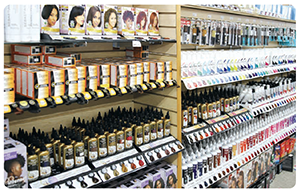
There are simply too many colors to know them all..
– If a regular or a persistent customer insists on refund, (provided that the item is in original condition) we allow credit chargebacks but collect a small fees, typically $2. When you cancel a credit card transaction, the store will still pay the credit payment fees, so the fees are reasonable.
– In my case, I simply offer return unless it’s human hair or ponytail. Even if it’s not from our store, as long as I can sell them at the store, I offer exchange. Customers will remember how the store treated them for returns forever. Unless it involves a big loss or financial burden, I side with the customer.
– There are times that customers bring a bag full of wigs or ponytails and ask for refund. I preemptively say, “I don’t need to see. No return no exchange. It’s final sale.” Once they open it up, you lose. They will go into details of what is wrong with this and what is wrong with that. When they blame the your associates, it gets out of your hand. Offense is the best defense.
Case 3 Shoplifting as if they have rights
National Association for Shoplifting Prevention (NASP) estimates that one in 11 retail customers are shoplifting. Beauty supplies are estimated to have 3-5% loss due to the shoplifting in the sales revenue. The shoplifting techniques are diverse. Baggy sacks and pockets in hoodies are common places to hide the stolen goods. When they go a step further, they will have an inner surface covered with aluminum foil or simply bring a cooler bag. When someone brings a strong magnet or sensor tag remover, they are there for shoplifting. They often buy an item while stealing many. Sometimes you discover a security camera footage of shoplifting after you give a refund for unopened items. When the sensor triggers alarm at the entrance, some just stay put without admitting any fault.
Here’s how we handle it.
– For checked out items, you place a sticker with strong adhesive. This will make sure whether the product was purchased at your store or not. When you mark the price tags with your store name, you can prevent someone asking for a refund for items bought somewhere else.
– To prevent theft, you can place security tag stickers on the product. If you do not remove the tags at the cashier, they will trigger alarms at the entrance.
– When the alarm is triggered, you should be extra polite approaching the customer. Don’t say “I need to see your bag” but say “one of the employees might have missed a tag. Can I check for them?” If the customer feels that the store is not accusing them of theft, most customers will let you search the items. If they indeed shoplifted? You are not going to catch them anyway. When the alarm is triggered, they would simply storm out with stolen goods.
– For petty theft, we deal with it without involving the law enforcement. Just for a couple of dollars, would you call the police and go to the court? The time waste and stress will surpass whatever good you would achieve. You don’t want to burn down the entire house to get rid of bed bugs.
– If you try to view the incident from their perspective, you might feel better. “How dare they get so offensive about just a couple of dollars when I spent fortune at this store?” That’s how they would feel, and you should be sensitive about that.
– Any retail stores suffer loss from shoplifting. Some of the beauty supply customers who caught for shoplifting would simply admit the wrongdoing and later come back as if nothing happened. Because that could be your case, try to make a peaceful ending while trying to retrieve the stolen goods.
*Episode 1
We had a regular customer who we knew quite well. She was a customer who was introduced by a local police officer as his wife. She would often drop by the store, meet and greet, browse, and buy at least one item, maybe an inexpensive item from the $0.99 deal. One day, one of the staff members made hand gestures behind her, telling she’s stealing goods. She’s a shoplifter? There was no way. Her husband was a local police officer. However, the employee repeated that she was certain. Having a serious doubt, but still I asked the customer to open her bag. She was very upset and pulled out almost $40 worth goods with trembling hands. “I’m sorry. I won’t come back.” And she left. She was indeed not around for a while but made a comeback. I simply believed that she wouldn’t do it again.
The retail business owner says, “Local thefts are actually helping your business. They usually steal one or two items while paying for what they need. They usually steal petty items like a lip gloss. Quite literally “petty thefts” that do little harm. The real problem is people who come in an out-of-state registered vehicle and with a full intent to make money from stealing. They would park their car right in front of the entrance, facing outwardly, and they would run with items ignoring alarms. Some of them bring U-haul trucks to avoid being tracked. When you think of these people, loss from petty theft is more like cost of running a retail business.
Case 4 Beauty supplies are the playground of children
Female customers are likely the majority of your clients, and many of them have big families. It’s avoidable that people bring their kids to shop. There is a saying “4-year-old is bad, but 7-year-old is impossible.” They are out of control at certain ages, and beauty supply owners should be on a watch. When children ran through the aisles packed with merchandise, you need to worry about product damages, injury to the customers, and so on. You should be on a high alert till they leave.
Here’s how we handle it.
– We posted a warning sign in the store. “We are NOT responsible for any injuries caused by running, playing, wearing no shoes, and other reckless acts in the store.” This is a sure way.
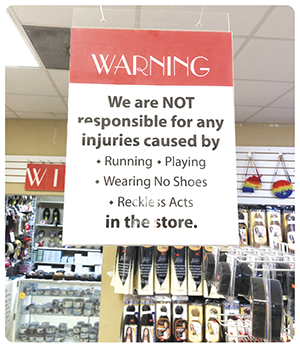
Signage posted at a beauty supply store in Louisiana
– When children dangerously run in the store, you should give them heads up to prevent potential accident. You’d better talk to the parents politely rather than approaching and talking to the kids. When you scold a kid, no parent will feel good about it.
– We buy 5 lbs of candy a week to place in the candy basket on the retail floor. It is a carrot for trouble makers before they even try. Some parent customers have negative views about their kids having candies, so you’d better ask the parent first: “is it okay to give him/her a candy?” Most of the time, they would say, “Of course, thank you.”
Case 5 Customers who damage goods with their hands
Although you can stop them from trying on, you can’t really stop them from touching a wig product. They want to feel the product with hands to examine the texture of hair in addition to visual inspection. However, when touching becomes a little overboard, wigs can get damaged. Especially when customers try to feel the curls by rubbing them with fingers.
Some customers try to open the chemical products packaged in boxes. They usually want the following three. They want to smell the scent. They wonder the texture. They want to make sure nobody has opened the boxes and tried it.
Here’s how we handle it
– We prevent opening of a product beforehand. Simply you position a price tag or sticker where it sticks to both the container and its lid or cap. Of course, some customers will peel the sticker to open it. Then, you could just approach her quietly and ask “you’re gonna buy it, right?”
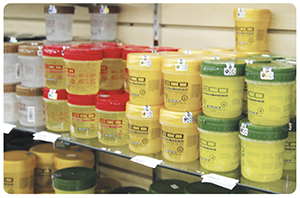
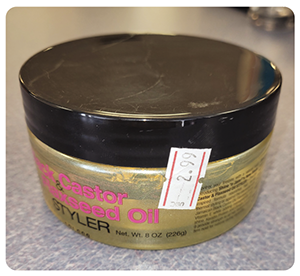
Products with Sticker tags and price tags
– When I see a customer who is looking at a chemical product closely, I would go and open the container myself for her. Let her smell the product, and if she wonders the texture, I ask her to touch the product on the lid. Well, many of them actually buy it after going that far.
– For wigs, we place notices that they should not damage the products by running fingers through the curl. You should be ready to explain to the customer that when the curl gets loose or messy, it is tough to correct.

*** For wigs, before the Covid-19 we allowed up to three try-ons for wigs, but nowadays every business forbids trial or styling a wig before purchasing it. Quite a number of business owners and employees seem to wish that this policy may continue after the Covid-19.
Case 6 Don’t like the service! Customers making a scene
Especially when a new staff member joins, they would look down on the employee for lack of knowledge, and they often say “why don’t you give me a discount that the business owner or manager used to give me?”
At times, they would talk behind the employee about poor customer service or even make formal complaints with the store.
Here’s how we handle it
– Knowing is winning! Beauty market is more fast-paced than any other, so you should keep studying. You should at least show that you know more than they do.
– You care even more. Warmly welcome a customer and remember their name and purchase habits. If nothing works? You need to sometimes bring your poker face.
*Episode 2
There was a group of customers who went to the same church at a small town. Before long after the grand opening of my beauty supply store, they would come to call me names although I was right there. When I was serving another customer, they would say, “Look at this. They ignore us. What is this?” to the face. They often asked for a group discount. Because it was early on for the business, so I tried hard to make good relationship. Nothing really worked. In three years, right before Christmas, I exploded. They were acting rude as always, and I said, “don’t say bad things right in front of me. I’m not gonna deal with you anymore. Please leave my store.” They left the store pretty upset, but after a few months, they came back for their needs and made positive changes in their behavior. I thought why didn’t I say something earlier. Being acquiescence always is not the answer. You sometimes have to confront them.
Case 7 Accidents and injuries
Small or large, beauty supplies tend to pack the retail floor with an overflowing number of merchandise. This can cause accidents and injuries. Some shoppers trip over goods on the floor while others bumps into tight aisles or get scratched by them. (In fact, a retail store reported that a customer had laceration around an eye after bumping into a frame.) When the floor is wet after cleaning, it gets slippery and people can fall. There are abusers. There was a customer who claimed for fall injury caused by wet floor. Indeed, water spill was found on the floor. However, the morning cleaning ended a while ago, and no one spilled water or carried a bottle of water including the customers. We suspected a set-up, but there was no evidence.
Here’s how we handle it
– To reduce accidents, we constantly check the stock items and aisles for any potential threat. After wet mopping the floor, post the wet floor sign at all times.
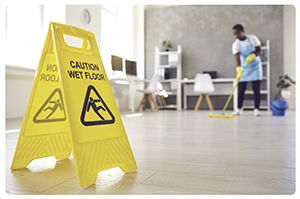
– When you have a customer claiming injury within the premise, politely notify that you need to call the police. When the officers arrive, check the security camera footage to find out who’s at fault. It might be the negligence on the customer side, such as paying no attention to where they are going while talking on the phone.
– If a customer asks for compensation, you should always ask them to see a doctor first. You should state that you need a document for the insurance claim that the store will be filing. (Not many come back actually go to see a doctor.)
– There was a customer who went to the corner that had a Do Not Enter sign. She left saying she’s okay, but she later received thousands of dollars from insurance. However small, the store should be thorough with the follow-up.
*Episode 3
Even if you have an unforeseen event, goodwill existing with the customer can help out the situation. At a retail store located in Southeast, regular sanitization was taking in practice in the midst of the pandemic. After they sprayed the floor and before it was cleaned up, a regular customer walked on it and fell, breaking her leg. We called 911 and accompanied her to the hospital. We were about to file an insurance claim. The customer said, “I’m on medicare. The government pays. Don’t worry and just go.” So far $400 for the cast she put on, and other hospital charges were pending. She took care of everything. The business owner decided to offer her choice of goods free of charge for the next month, but after the scanning the items and she was told to go without paying, she always said, “I’m paying for it.” This tells how important it is to generate goodwill with a customer. How wonderful would it be if every customer was like that?
Your mindset when dealing with a difficult customer
One of the basic principle of retail business is “customer is always right.” Serving the customers is the foundational purpose of the business. Hence, when you have trouble with them, you should listen to them. Addressing issues appropriately and turn their negative experience into a positive one depend on you, the business owner.
YouTuber Prof. Park @All_about_Service who studies customer service suggest U-ATE approach to transform the business-customer relation into a mutually beneficial one and do not fixate on a difficult customer.
– “U”nderstand: You do not need to always say yes, but you should always try to understand and sympathize with the customer. Even if you don’t agree with a customer’s complaint, you should say, “Did you feel that way?” instead of “You’re wrong to feel that.” Finding a mutual ground to understand the customer’s situation should be your job.
– “A”pologize: When there is a misunderstanding or mistake, you should apologize with proper acknowledgment that what was wrong and how regretful you are. “I should’ve checked more thoroughly, and I’m sorry for your inconvenience.” and “I’m sorry to make your visit with us an unpleasant one for the customer service that didn’t meet our standard.”
– “T”hank your customer: Not all customers bring up their complaints. Most of them would simply walk out thinking “I’m not coming back.” Hence, you should thank them for giving an opportunity to address the customer service issue. “I sincerely thank you for letting us know what we might’ve missed.”
– “E”xplain: Don’t stop at just saying thank you, but promise a solution and make it your moral responsibility to fix the issues or provide alternatives. However, you should have a clear rule about how much your store should do for a certain kind of problem. If you treat your customers differently, like you give more generous solutions to some while ignoring others, it will make things worse in a long term.

Responding to customer complaints and claims with real life stories
Advice from Beauty Supply Veterans
Beauty supply business owners and managers who worked in the field for a long time share valuable tips and know-hows from their experience. Let’s find out how they do it and their philosophy in dealing with customers.

– “Don’t confront the customer” is our store-wide policy. When they raise a volume, you should speak even softer. When they realize how loud they are, it might calm them down. Don’t ever raise your voice with them.
– A few complainers are not harmful. Customer complaints are just part of business, so you shouldn’t try to take care of them all. You simply stay low with them and provide the unlimited customer service. Greet them every time and be kind. Sometimes, they make a visit to complain but end up trying to be nice to you.
– There are store owners who avoid touching customers’ hands. Simple acts like placing change on the counter instead of handing it over to them can give customers an idea about how you think about them.
– Be grateful for customers especially for African Americans. For 2-300 years, they made a great effort to overcome the racial disparity and discrimination through which we have today’s laws for civil rights. We owe them a lot for being just piggybacking on them. Don’t we enjoy the same equal treatment they fought for? If you understand their history, you would know why they feel so offended for tiny bits of happenings and why they so want to be treated with respect.
– Retail business owners must have a stress management routine. When you build up stress, you may end up venting it to the manager, then the manager to employees, and the employees to customers.
– A 20-year veteran manager says, “beauty supplies are local business, so you will see everyone again.” Customers who yelled at you for being mistreated today will come back tomorrow. Even if you feel really bad, you just stay calm and act like a professional. Difficult customers have a desire to be “acknowledged” by you. Those difficult customers may turn to super loyal customers after you treat them with great care.
– A 20-year veteran business owner says, “To work in the field of beauty supply for more than a decade, you need to be a monk. Otherwise, you will grow ill feelings.”
Praises to the monks who welcome customers with warm smiles while enduring painful feelings inside.